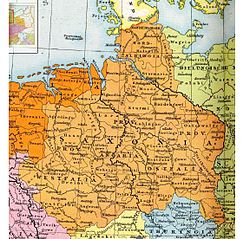Old Saxony
| Old Saxony | ||||||||||
| Tribal territory of the Saxons Early medieval duchy |
||||||||||
|
||||||||||
|
The later stem duchy of Saxony (circa 1000 CE), which was based in the Saxons' traditional homeland bounded by the rivers Ems, Eider and Elbe
|
||||||||||
| Capital | Marklo | |||||||||
| Languages | Old Saxon | |||||||||
| Government | Tribal confederation | |||||||||
| Historical era | Early Middle Ages | |||||||||
| • | Hadugato, first documented duke | c. 531 | ||||||||
| • | End of the Saxon Wars | 804 | ||||||||
|
||||||||||
Old Saxony is the original homeland of the Saxons in the northwest corner of modern Germany and roughly corresponds today to the modern German state of Lower Saxony, Westphalia and western Saxony-Anhalt.
Adam of Bremen, writing in the 11th century, compared the shape of Old Saxony to a triangle, and estimated from angle to angle the distance was eight days journey. In area Old Saxony was the greatest of the German tribal duchies. It included the entire territory between the lower Elbe and Saale rivers almost to the Rhine. Between the mouths of the Elbe and the Weser it bordered the North Sea. The only parts of the territory which lay across the Elbe were the counties of Holstein and Ditmarsch. The tribal lands were roughly divided into four kindred groups: the Angrians, along the right bank of the Weser; the Westphalians, along the Ems and the Lippe; the Eastphalians, on the left bank of the Weser; and the Nordalbingians, in modern Holstein. But not even with these four tribal groups was the term of tribal division reached. For the Saxon “nation” was really a loose collection of clans of kindred stock. For example, the Nordalbingians alone were divided into lesser groups: Holsteiners, Sturmarii, Bardi, and the men of Ditmarsch.
Old Saxony is the place from which most of the raids and later colonisations of Britain were mounted. The region was called "Old Saxony" by the later descendants of Anglo-Saxon migrants to Britain, and their new colonies in Wessex and elsewhere were the "New Saxony" or Seaxna. In Germany the Saxon lands were known simply as "Saxony" (Modern German:Sachsen) and only later came to be called Lower Saxony, to differentiate those original Saxon tribal territories from what became the Kingdom of Saxony or Upper Saxony in territories far to the south-east of the original Saxon homeland. The Anglo-Saxon writer Bede claimed in his work Historia ecclesiastica gentis Anglorum (731) that Old Saxony was the area between the Elbe, the Weser and the Eider in the north and north west of modern Germany and was a territory beyond the borders of the Roman Empire.
...
Wikipedia

